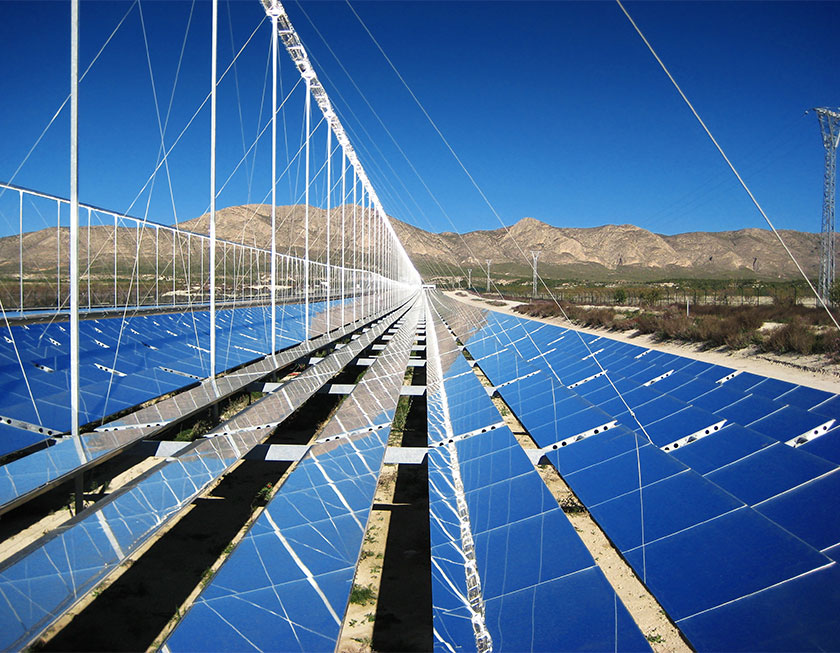3.3 Concentrated solar power (CSP): How does it work?

In the previous article, we discussed two concentrating solar power technologies. In this article, we are going to discuss some other concentrating solar power systems, in detail.
3. Linear Fresnel Systems
Just like parabolic trough systems, linear Fresnel reflectors create a linear focus above them along which is a fixed linear heat absorbing receiver. Fresnel reflectors are flat or marginally curved mirrors equipped with single-axis solar trackers. Just like in other concentrating solar power systems absorbed heat is used to produce steam which turns a turbine and generate electricity.

Figure 01: A diagram of a linear Fresnel solar thermal power system with alternatively inclined mirrors
As shown in the above figure, some systems use alternatively inclined mirrors with two linear heat receivers. This configuration helps reduce the space required and also helps avoid any blocking between the mirrors.

Figure 02: A linear heat receiver of a linear Fresnel solar thermal power system
As shown in above figure 02, these systems have a smart configuration that their heat receiver is always fixed, pointing down, and the exterior of the receiver is well-insulated. This design avoids convective heat loss, minimize radiative loss and improves the system energy conversion efficiency.
The fundamental advantage of linear Fresnel reflectors is their simple geometry. Simply, they are easy and cheap to be fabricated since they are flat or slightly bent mirrors. These systems are more efficient than power tower systems but not competent than dish Stirling systems or parabolic trough systems. The demonstrated annual efficiency is in the range of 9- 11%. Anyway linear Fresnel systems are believed to be a good alternative to parabolic trough systems in terms of the cost, simplicity and land-use efficiency.
4. Power Tower Systems (Center receiver systems)

Figure 03: A power tower system
A typical concentrated solar thermal power system employs hundreds of heliostats to concentrate solar radiation onto a receiver installed on a tall tower. Heliostats are large mirrors with two-axis sun-tracking systems which help follow the Sun’s path precisely and thereby significantly improve the overall system efficiency. Inside the receiver is a heat transfer liquid which absorbs focused heat and transfers to a working fluid to produce steam. Just like in coal-powered or diesel-powered plants, the next part of the system is a steam turbine connected to a generator.
These systems usually reach a temperature of 800 ˚C- 1000 ˚C or even higher by concentrating solar radiation 600- 1000 times. The key advantage of these systems is that they archive higher energy concentration ratios and higher temperatures at a single receiving station which allows generating electricity using a single steam turbine, and an electric generator. However, the demonstrated annual efficiency of these systems is in the range of 8- 10%. That means the annual conversion efficiency of power tower systems is almost half that of dish Stirling systems. Furthermore, power tower systems require a large open area to receive and concentrate sunlight. Therefore, this model is more suitable for deserts and barren or infertile locations.
Other concentrating solar power technologies
Concentrated photovoltaics where Fresnel lenses are used with solar PVs to concentrate sunlight onto solar PVs is also considered to be a concentrated solar power technology. Unlike other concentrating solar power technologies, this concept is not a solar thermal technology as it does not employ heat receivers, steam generators, turbines and electric generators to generate electricity. Instead, they use solar photovoltaics onto which sunlight is focused using Fresnel lenses.
Let us discuss concentrated photovoltaics technology in a separate article in detail.
References
[1] Müller-Steinhagen, H., & Trieb, F. (2004). Concentrating solar power. A review of the technology. Ingenia Inform QR Acad Eng, 18, 43-50.
Image credits
- By Jrkenneyjr – Own work, Public Domain, https://commons.wikimedia.org/w/index.php?curid=9722370
- By Jrkenneyjr – Own work, Public Domain, https://commons.wikimedia.org/w/index.php?curid=9722289
- By afloresm – SOLUCAR PS10, CC BY 2.0, https://commons.wikimedia.org/w/index.php?curid=2821733
- http://www.stelaworld.org/introduction/
